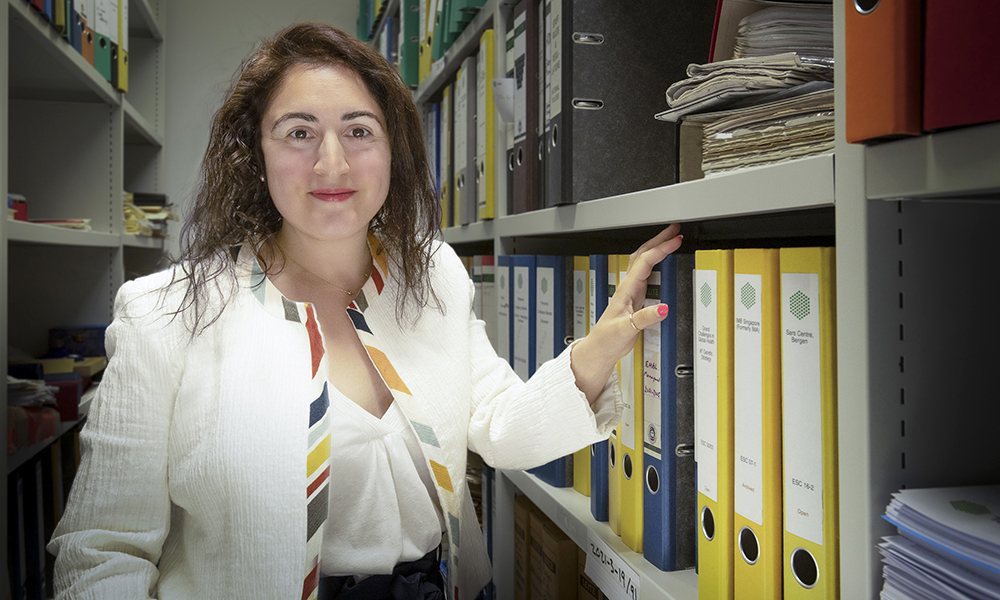
Read the latest Issue
EMBL’s new archive and record manager explains how communication and engagement are central to her dual role of preserving history and managing EMBL records

With EMBL’s new Office of Science Information Management (OSIM), comes new challenges for the two people who will simultaneously work as archivists and record managers.
Maria Papanikolaou, the first to assume this new role that combines these different tasks, is excited by the merger of preserving EMBL history with managing records. She explained the value of engaging with stakeholders, why she loves the outreach aspect of her work, and how she has long appreciated and been fascinated by history.
In the new structure, the EMBL Archive, Records Management, Open Science, and the Szilárd Library are all part of the newly established Office of Scientific Information Management (OSIM). Previously in separate places at EMBL, these merged activities should allow us to better manage EMBL data – from creation to selection and preservation to access – and ensure consistency in practices and user communication. A new Archives and Records Management User Group will also give a user-centric approach to our work.
My role in the OSIM is as an archivist and records manager. As a historian, I love working in the archives, researching and describing collections, and creating archival narratives. However, I also have a solid background in records management. I’m looking forward to building relationships with our main stakeholders at EMBL and beyond.
The EMBL Archive and Records Management vision is integral to information governance. So, I am part of a team that will be the hub for specialist support, advice, and guidance on the management, preservation, and access to EMBL-specific information. This includes scientific, institutional, and administrative active and inactive records/data, as well as historical archives. We believe this will set us up as a role model for other similar institutions. The first EMBL Archive and Records Management User Group can help us realise this vision. As we engage with EMBL offices and key stakeholders, we will foster collaboration as well.
Many interesting, multi-faceted stories are in the EMBL Archive with its oral histories and material artefacts from former scientists, such as instruments, lab books, and personal papers. But for me, it is also exciting how people engage with the archive and witnessing that first hand.
For example, a retired staff member came in to submit a 1984 EMBL laboratory course manual. He had been a PhD student at EMBL and relayed how this Cell Biology course included one of the world’s leading biologists, Thomas Kreis, who tragically died during the Swissair Flight 111 crash on 3 September 1998.
On another occasion, a young scientist sought pictures to create a commemorative album. Looking through the archival photographic collections, I was just as drawn in as the scientist as we experienced the lives of these people from EMBL’s past.
The archive isn’t just about preserving and providing access to an institution’s history, but also to the smaller stories of EMBL’s community of people. These are special moments for me – connecting with the people at EMBL and seeing the impacts of our archive.
For the previous four years, I worked as the Assistant University Archivist at the American University in Cairo (AUC), working on archival projects and heading the records management team. I studied history and archaeology at the National University of Athens, Greece, and obtained a master’s degree in modern and contemporary Greek and European history there as well. Additionally, I got a second master’s in archival science at Leiden University in the Netherlands.
As a child, I enjoyed reading historical books, watching historical documentaries and movies, and listening to my grandparents talk about Italian colonialism in my homeland, Rhodes Island, and World War II. My interest deepened as a teenager when I decided to study history. Historical research brought me in contact with archival work. I got interested in how the ‘raw history’ – the archives – is created and how it contributes to preserving history. I appreciate the benefits of my dual job as the historian analysing archival material and as the archivist who makes records accessible.
One Hundred Years of Solitude, by Gabriel García Márquez, left a strong impression on me – so much so that I read it in four days. I love how Márquez uses metaphor and symbolism to talk about people and history. The combination of ‘magical realism’ with the exciting and touching history of Latin America gripped me.
Meeting people and working in a very collaborative, communicative way with the EMBL community! EMBL has an international atmosphere while being based in a small city. It’s a warm, friendly work environment. While I am still emotionally connected to my previous life in Egypt, I have never felt alone here.
Looking for past print editions of EMBLetc.? Browse our archive, going back 20 years.
EMBLetc. archive